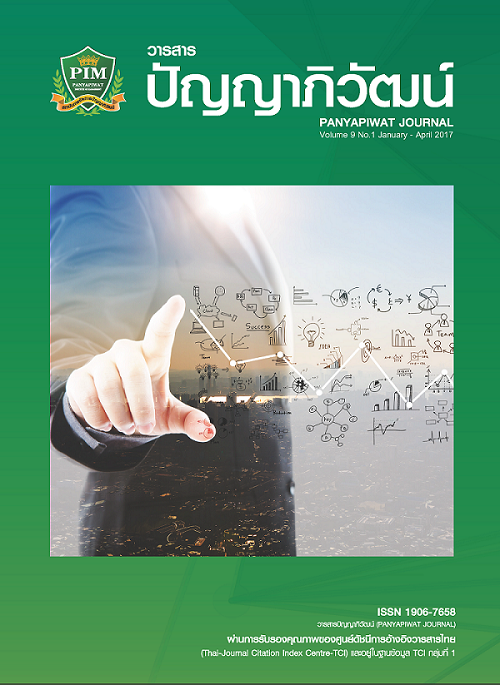การวิเคราะห์ปัจจัยของการตลาดด้วยเนื้อหาที่มีผลต่อความไว้วางใจของกลุ่มผู้ซื้อเสื้อผ้า ในธุรกิจพาณิชย์อิเล็กทรอนิกส์
Main Article Content
บทคัดย่อ
การวิจัยในครั้งนี้มีวัตถุประสงค์เพื่อศึกษาอิทธิพลของการตลาดด้วยเนื้อหาในรูปแบบของอินโฟกราฟิกและการสื่อสารด้วยการบอกต่อแบบปากต่อปากทางอิเล็กทรอนิกส์ที่มีผลต่อความไว้วางใจของกลุ่มผู้ซื้อเสื้อผ้าในธุรกิจพาณิชย์อิเล็กทรอนิกส์ กลุ่มตัวอย่างคือ ผู้ที่เคยซื้อเสื้อผ้าในธุรกิจพาณิชย์อิเล็กทรอนิกส์จำนวน 400 คน การวิจัยนี้ใช้ระเบียบวิธีวิจัยเชิงปริมาณ ทดสอบสมมติฐานโดยการทดสอบการถดถอยพหุคูณ
ผลการวิจัยพบว่า การสื่อสารทางการมองเห็นในรูปแบบของอินโฟกราฟิกมีอิทธิพลเชิงบวกต่อความไว้วางใจของผู้เสื้อผ้าในธุรกิจพาณิชย์อิเล็กทรอนิกส์ โดยตัวแปรที่มีอิทธิพลคือ อินโฟกราฟิก 60% (ß = 0.442) และอินโฟกราฟิก 30% (ß = 0.148) การสื่อสารด้วยการบอกต่อแบบปากต่อปากทางอิเล็กทรอนิกส์มีอิทธิพลเชิงบวกต่อความไว้วางใจของผู้เสื้อผ้าในธุรกิจพาณิชย์อิเล็กทรอนิกส์ โดยตัวแปรที่มีอิทธิพลเชิงบวกคือ ความสามารถในการชักจูงโน้มน้าวใจ (ß = 0.581) ความถูกต้อง (ß = 0.187) และความชัดเจน (ß = 0.088)
The purpose of the study was studied the effect of content marketing in infographic and electronic word of mouth communication that affected on trust of apparel customers in electronic commerce. The samples were 400 of apparel customers in electronic commerce. This study was quantitative research that used multiple regression to test the hypotheses.
The study found that the content marketing in infographic positively affected on trust of apparel customers in electronic commerce. The most positive effective factors was infographic 60% (ß = 0.442), followed by infographic 30% (ß = 0.148). Conversely, infographic 0% (ß = -0.047) was ineffective. The content marketing in electronic word of mouth communication that positively affected on trust of apparel customers in electronic commerce. The most positive effective factors was persuasive (ß = 0.581), followed by accuracy (ß = 0.187) and clarity (ß = 0.088).
Article Details
“ข้าพเจ้าและผู้เขียนร่วม (ถ้ามี) ขอรับรองว่า บทความที่เสนอมานี้ยังไม่เคยได้รับการตีพิมพ์และไม่ได้อยู่ระหว่างกระบวนการพิจารณาลงตีพิมพ์ในวารสารหรือแหล่งเผยแพร่อื่นใด ข้าพเจ้าและผู้เขียนร่วมยอมรับหลักเกณฑ์การพิจารณาต้นฉบับ ทั้งยินยอมให้กองบรรณาธิการมีสิทธิ์พิจารณาและตรวจแก้ต้นฉบับได้ตามที่เห็นสมควร พร้อมนี้ขอมอบลิขสิทธิ์บทความที่ได้รับการตีพิมพ์ให้แก่สถาบันการจัดการปัญญาภิวัฒน์หากมีการฟ้องร้องเรื่องการละเมิดลิขสิทธิ์เกี่ยวกับภาพ กราฟ ข้อความส่วนใดส่วนหนึ่งและ/หรือข้อคิดเห็นที่ปรากฏในบทความข้าพเจ้าและผู้เขียนร่วมยินยอมรับผิดชอบแต่เพียงฝ่ายเดียว”
เอกสารอ้างอิง
Ahearne, M., Gruen, T. & Saxton, M. K. (2000). When the product is complex, does the advertisement’s content matter?. Journal of business research, 48, 55-62.
Bartikowski, B. & Merunka, D. R. (2015). Modeling the effects of the Three Dimensions of Trust towards the e-vender on Online Consumer Behavior. AIS Electronic Library (AISEl.), 20(1), 24-56.
Chih, W. H., Wang, K. Y., Hsu, L. C. & Huang, S. C. (2013). Investigating Electronic Word-of-Mouth Effects on Online Discussion Forums: The Role of Perceived Positive Electronic Word-of-Mouth Review Credibility. Cyberpsychology, behavior and social networking, 16(9), 658-665.
Electronic Transactions Development Agency. (2015). The 2015 Thailand survey on the use of internet. Retrieved February 2, 2016, from https://www.etda.or.th/documents-for-download.html [in Thai]
Fang, Y. H. (2014). Beyond the credibility of electronic word of mouth: Exploring eWOM Adoption on social Networking site from affective and curiosity perspectives. International journal of electronic commerce, 18(3), 67-101.
Feng, B. & Burleson, B. R. (2009). The effect of argument explicitness on responses to advice in support interactions. Communication research, 35(6), 849-74.
Few, S. & Edge, P. (2011). Infographic and the brain designing graphics to inform. Report at the Malofiej 19 Pamplona Spain. March 24, 2011.
Fitzgerald, B. (2013). B2B Marketers or Getting better at content marketing. Retrieved February 2, 2016, from https://blog.brightcove.com/en/2013/10/b2b-marketers-are-getting-better-content-marketing
Heu, J. H. (2008). The study on the factors of the effect on trust and loyalty in online shopping mall. Master thesis, Chung-Aug University, Seoul.
Holliman, G. & Rowley, J. (2014). Business to business digital content marketing: marketer’s perceptions of best practice. Journal of research in interactive marketing, 8(4), 269-293.
Intaratayvee, T. (2013). Thai people’s attitudes towards infographic and texts as means of communication for social campaigns.
The degree of Master of Arts program in strategic communication management, Chulalongkorn University. [in Thai]
Kestler, J. L. (2010). Intergenerational fashion influences: Mother/daughter relationships and fashion involvement, fashion leadership, opinion leadership and information seeking from one another. The college of health and human service, Ohio University.
Kim, H. & Song, J. (2010). The quality of word-of-mouth in the online shopping mall. Journal of research in interactive marketing, 4(4), 376-390.
Leeraphong, A. & Mardjo, A. (2013). Trust and Risk in Purchase Intention through Online Social Network: A Focus Group Study of Facebook in Thailand. Journal of Economics, Business and Management, 1(4), 314-318.
Lin, T. M. Y., Lu, K. Y. & Wu, J. J. (2012). The effects of visual information eWOM communication. Journal of research in interactive marketing, 6, 7-26.
Ling, K. C., Daud, D. B., Piew, T. H., Keoy, K. H. & Hassan, P. (2011). Perceived Risk, Perceived Technology, Online Trust for the Online Purchase Intention in Malaysia. International Journal of Business and Management, 6(6), 167-182.
Mackinnon, K. A. (2012). User generated content vs. Advertising: Do consumer trust the word of other over advertisers. The Elon Journal of undergraduate research in communications, 3(1), 14-22.
Mangiaforte, L. B. (2015). The 20 best infographic of 2015. Retrieved January 3, 2016, from https://marketinginsidergroup.com/content-marketing/best-infographics-2015
Meeusah, N. (2013). Effect of data set and hue on a content understanding of infographic. The degree of master of mass communication technology, Rajamangala University of Technology Thanyaburi. [in Thai]
Meskaran, F. M., Ismail, Z. & Shanmugam, B. (2013). Online Purchase Intention: Effect of Trust and Security Perception. Australian Journal of Basic and Applied Sciences, 7(6), 307-315.
Milovanovic, D. & Ivanisevic, L. (2014). Infographic as a marketing communication tool. In 2014 New business model and sustainable competitiveness symposium proceeding, (p. 266-272).
National Statistical office. (2014). The 2014 Household survey on the use of information and communication technology. Retrieved February 2, 2016, from https://service.nso.go.th/nso/nsopublish/service/survey/ICT-HouseExc57.pdf [in Thai]
Phattrarayuttawat, S. (2002). Manual of Psychology Cal Testing. Bangkok: Medical media printing. [in Thai]
Ponte, E. B., Carvajal-Trujillo, E. & Escobar-RodrÍguez, T. (2015). Influence of trust and perceived value on the intention to purchase travel online: Integrating the effects of assurance on trust antecedents. Tourism Management, 47, 286-302.
Robbins, S. P. & Coulter, M. (2005). Management. US: Prentice Hall.
Sawyer, A. G. & Howard, D. J. (1991). Effect of omitting conclusions in advertisements to involves and uninvolved audiences. Journal of marketing research, 28(4), 476-74.
Silpcharu, T. (2014). Manual Research and statistical analysis with SPSS and AMOS. Bangkok: Business R & D printing. [in Thai]
Svensson, A. (2011). Facebook-the social newspaper that never sleeps. Master degree project. Master of Science in marketing and consumption, University of gothenburg.
The A Group. (2013). Content marketing for ministries 101. Retrieved January 3, 2016, from www.agroup.com
Wolny, J. & Mueller, C. (2013). Analysis of fashion consumers’ motives to engage in electronic word of mouth communication through social media platforms. Journal of marketing management, 29(5-6), 562-583.
Zehir, C., Sahin, A., Kitapci, H. & Ozsahin, M. (2011). The effect of brand communication and service quality in building brand loyalty through brand trust; the empirical research on global brand. Procedia - Social and Behavioral Sciences, 24, 1218-1231.


